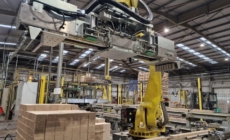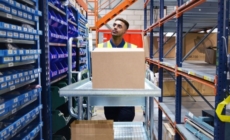-
Tower Launches Customer Sustainability Hub with Practical Tools for Lower-Impact Pharmaceutical Cold Chain - October 16, 2024
-
Six decision-making models for best practice WMS digital transformation - October 16, 2024
-
“Transforming Logistics: Precision and Purpose” – BIFA takes centre stage - October 15, 2024
-
JAMES JONES & SONS LTD EXPANDS ITS PALLETS & PACKAGING DIVISION THROUGH THE ACQUISITION OF HG TIMBER LTD - October 10, 2024
-
HUGO BECK EXPANDS MACHINE RANGE FOR E-COMMERCE, MAIL ORDER AND LOGISTICS - October 10, 2024
-
Winning Irish Exporter of the Year, Combilifts CEO Martin McVicar talks about the journey into the Global Market - October 8, 2024
-
JAMES JONES & SONS’ AUSTRALIAN SUBSIDIARY, HYNE GROUP, EXPANDS TO WESTERN AUSTRALIA - October 3, 2024
-
QUECLINK LAUNCHES SOLAR-POWERED ASSET TRACKER FOR TRAILERS AND CONTAINERS - October 3, 2024
-
Southgate Global Calls for Greater Health and Safety in the Warehouse Back Care Awareness Week - October 3, 2024
-
Nulogy to Expand Capabilities with Strategic Acquisition of Mingo Smart Factory - October 3, 2024
Logistics automation not only tackles the lack of labour in warehouses and distribution centres today, it also helps cultivate a culture of safety and innovation.
Most traditional warehouses require employees to manually lift and carry crates of goods that are often heavy. Repetitive twisting, turning and reaching put warehouse staff at constant risk of injury, which potentially leads to long-term physical harm. Particularly in times of labour shortage, manual order fulfilment results in warehouse staff having to work harder and faster, increasing their risk of workplace injury. By eliminating these ergonomic hazards, automation marks a transition from the traditional, physically demanding warehouse to more modern facilities that run better, faster and safer operations.
Healthy workplace means productive workforce
Ergonomics is not just a buzzword. In fact, employee well-being and safety are some of the top reasons behind the decision to automate distribution centres, together with greater reliability in distribution. A safer workplace leads to healthier workers, lower injury costs, less stress and higher employee retention.
“Crates handled manually are often heavy,” explains Kari Miikkulainen, Director of Warehouse & Distribution Industry Sales at Cimcorp. “In grocery distribution, for example, workers may be lifting crates of fruit and vegetables weighing over 25 kilos. Trucks are often loaded up to two metres high, and to pick up heavy crates from this height is very strenuous for the human body, not to mention the possible safety issues.”

Kari Miikkulainen, Director of Warehouse & Distribution Industry Sales at Cimcorp
In addition to the ergonomic challenges, insufficient staffing increases the operating pressures that beset manual distribution. Investing in workplace safety is vital to ensure the well-being of workers and stay competitive. Work hours lost to avoidable injuries hamper the productivity and efficiency of the warehouse.
Automation enhances operations and safety
Automation creates a safer workplace by taking high-risk tasks away from workers and also provides an opportunity to consolidate the entire distribution centre through system integration. From conveyors and automated guided vehicles (AGVs), to automated storage and retrieval systems (AS/RS) and order picking solutions, robotics and machinery can alleviate the demanding task of order fulfilment. These automated solutions can provide rapid and accurate movement of goods – from receiving through storage, replenishment and picking, to packing and shipping – optimising material flow from end to end.
With the help of automation, warehouses and distribution centres can eliminate the risks of injury, minimise employee strain due to absences and provide better job satisfaction. In addition, a workplace where injury prevention is the main goal helps to set the tone for a company’s commitment to safety. A positive safety culture has an influence on workers’ morale and turns them into safety advocates, directly impacting employee performance and retention.
Employees enjoy fulfilling, tech-driven positions
With automation, tasks for employees are elevated from repetitive, physical labour into more sophisticated work in terms of supervising operations and reviewing performance data. Today’s jobseekers gravitate more towards careers where they can apply some technological acumen, in addition to enjoying a safe work environment.

Automation elevates workers into supervisory roles
“The safety risks often make careers in warehousing and distribution less appealing to jobseekers and create difficulties in retaining employees,” says Kari Miikkulainen. “Automation can alleviate the physical burden for workers and elevate them into new, technical and supervisory roles. In effect, automated systems not only fill the operational gaps left by widespread labour shortages, but also protect current employees with more fulfilling, tech-driven positions. Thus, automation can present a drastic improvement in ergonomic conditions and the future outlook of distribution centres.”
Cimcorp wins award for proactive safety culture
Cimcorp, a pioneer of intralogistics automation, was recently awarded the highest occupational safety level classification in the Vision Zero Forum, led by the Finnish Institute of Occupational Health. The Vision Zero Forum is a network of workplaces aimed at motivating and encouraging companies to strive towards a high level of occupational health & safety and well-being at work. Cimcorp’s approach to safety encourages every employee to consider the safest way to complete each task before starting, fostering a reflective practice that supports a safe workplace. The company promotes a mindset that encourages each individual to care for their own safety and the safety of others.































